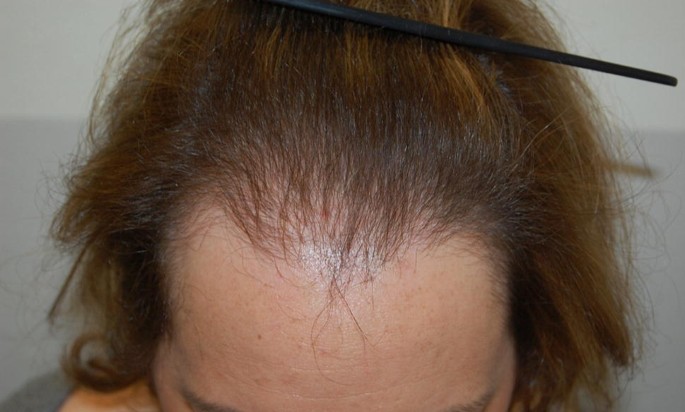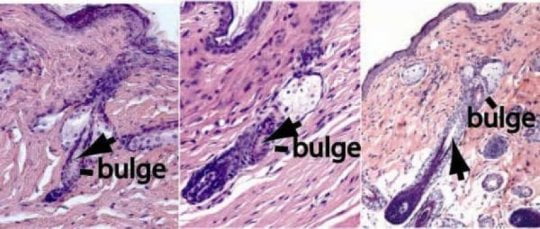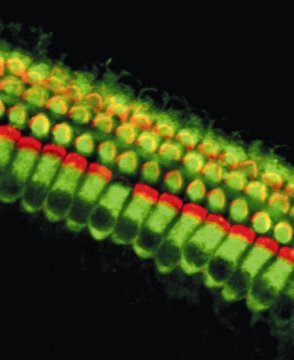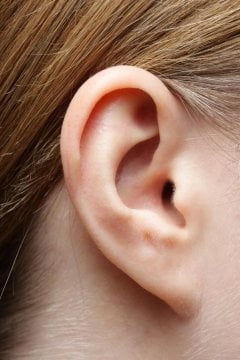
Background Distinguishing chronic telogen effluvium (CTE) from androgenetic alopecia (AGA) may be difficult especially when associated in the same patient.
Observations One hundred consecutive patients with hair loss who were clinically diagnosed as having CTE, AGA, AGA + CTE, or remitting CTE. Patients washed their hair in the sink in a standardized way. All shed hairs were counted and divided “blindly” into 5 cm or longer, intermediate length (>3 to <5 cm), and 3 cm or shorter. The latter were considered telogen vellus hairs, and patients having at least 10% of them were classified as having AGA. We assumed that patients shedding 200 hairs or more had CTE. The κ statistic revealed, however, that the best concordance between clinical and numerical diagnosis (κ = 0.527) was obtained by setting the cutoff shedding value at 100 hairs or more. Of the 100 patients, 18 with 10% or more of hairs that were 3 cm or shorter and who shed fewer than 100 hairs were diagnosed as having AGA; 34 with fewer than 10% of hairs that were 3 cm or shorter and who shed at least 100 hairs were diagnosed as having CTE; 34 with 10% or more of hairs that were 3 cm or shorter and who shed at least 100 hairs were diagnosed as having AGA + CTE; and 14 with fewer than 10% of hairs that were 3 cm or shorter and who shed fewer than 100 hairs were diagnosed as having CTE in remission.
Conclusion This method is simple, noninvasive, and suitable for office evaluation.
Patients with chronic telogen effluvium (CTE) characteristically present “with a history of hair loss with both increased shedding . . . of abrupt onset . . . and show diffuse thinning of hair all over the scalp. . . . ”1(p 899) Unfortunately, what “increased” actually means is not easy to establish, and thinning hair is observed only in patients with long-lasting CTE or is limited to the central zone of the scalp, mimicking or overlapping androgenetic alopecia (AGA). In fact, the association of CTE with preexisting AGA may be, given the prevalence of the latter in the general population, a common event.
Ruling out AGA on clinical grounds in such patients is not easy, and invasive procedures such as histopathological examination are difficult to apply in daily practice. Yet, as the pathogenesis and treatment of CTE and AGA are probably different, distinguishing the 2 conditions and understanding how relatively important they are when associated seems opportune.
We propose a simple and noninvasive method to accomplish this, based on the concept that vellus hairs have their own telogen phase that results in the extrusion of a shorter telogen hair. As AGA is determined by the increasing number of vellus hair, detecting a high number of telogen vellus hairs is likely to be a good measure of AGA, and vice versa; their low number in the presence of important hair shedding may indicate CTE.
Methods
We studied 100 consecutive patients (71 women and 29 men aged 14-78 years) who were seeking advice for hair loss. Patients who proved to have alopecia areata and scarring alopecias or having very short clipped hair were excluded.
Two of us (A.R. and F.V.) clinically diagnosed and scored AGA according to Hamilton and Ludwig scales, and CTE according to the following criteria: abrupt onset, duration over 6 months, precise memory of the time of onset, and positive pull test results in 4 areas of the scalp. Some patients, however, who fulfilled CTE criteria had also a manifest clinical AGA, while in others, without clinical signs of AGA but still complaining of hair loss, the pull test results were negative. The former group was diagnosed as having an association of AGA and CTE, and the latter was tentatively diagnosed as having CTE in remission. Of the 100 patients, 24 were clinically diagnosed as having AGA, 32 as having CTE, 39 as having AGA + CTE, and 5 as having CTE in remission.
All patients were then invited to undergo the following test: after 5 days of abstention from shampooing, they soaped and rinsed their hair in the sink or bathtub with the draining hole covered by a piece of gauze and collected all hairs caught in the gauze. The hairs were then gathered in a paper envelope and brought to the examiner. On “blind” examination (M.B.), they were counted and divided into 3 classes of length, namely 5 cm or longer, 3 cm or shorter, and intermediate length (>3 to <5 cm). In 24 patients (19 women and 5 men), we also measured the shaft diameter (M.G.), 0.5 cm above the club, of up to 10 hairs for each class of length and for each patient, by means of a video-microscope equipped with a ×200 original magnification lens (Video Cap; DSMedica, Milan, Italy).
We assumed that telogen hairs that were 3 cm or shorter were in fact telogen vellus hairs2 and decided that patients having at least 10% vellus hairs had AGA,3 whereas those who shed at least 200 hairs had CTE.4 Our patients’ conditions, therefore, were rediagnosed, from a numerical point of view, as having AGA (patients with more than 10% of hairs 3 cm or shorter and shedding of fewer than 200 hairs) and CTE (patients shedding 200 or more hairs longer than 3 cm). Patients who had hairs longer than 3 cm and shedding of fewer than 200 hairs and patients with 10% or more of hairs that were 3 cm or shorter who shed at least 200 hairs received the diagnosis of having CTE in remission and AGA + CTE, respectively.
We had then 2 sets of diagnoses, clinical and derived from the wash test. We calculated the Cohen κ statistic to evaluate the degree of concordance between the 2 diagnostic sets. Cohen κ statistic is a measurement of the agreement between 2 raters (or, in our case, rating methods) when the ratings are on a nominal scale.5
Results
The number of shed telogen hairs varied from 17 to 843 (Table 1). Patients clinically diagnosed as having AGA yielded figures of about 70 hairs (mean ± SD, 70.8 ± 29.5 hairs), those with CTE and AGA + CTE yielded figures of about 250 hairs (247.9 ± 187.1 and 225.1 ± 143.9 hairs, respectively), and patients with CTE in remission yielded figures of about 60 hairs (58.4 ± 13.4 hairs).
In patients with AGA and AGA+CTE, about 25% of hairs were 3 cm or shorter (25.2% ± 18.2% and 20.0% ± 16.5%, respectively), while in patients with CTE, whether in remission or not, most hairs (90.8% ± 6.5% and 85.6% ± 16.1%, respectively) were longer than 5 cm.
On the basis of the numerical criteria, 37 patients were diagnosed as having AGA, 14 as having CTE, 15 as having AGA+CTE, and 34 as having CTE in remission. The concordance between the data of clinical diagnosis and those of wash test diagnosis was not satisfactory (κ = 0.313).
Setting the cutoff shedding value at 100 hairs or more instead of 200 hairs or more, our figures changed as follows: there were 18 patients with 10% or more hairs that were 3 cm or shorter and shedding of fewer than 100 hairs, who were diagnosed as having AGA; 34 patients with fewer than 10% of hairs that were 3 cm or shorter and shedding of 100 hairs or more, who were diagnosed as having CTE; 34 patients with 10% or more of hairs that were 3 cm or shorter and shedding of 100 hairs or more, who were diagnosed as having AGA + CTE; and 14 patients with fewer than 10% of hairs that were 3 cm or shorter and shedding of fewer than 100 hairs, who were diagnosed as having CTE in remission. The concordance between diagnosis based on clinical criteria and diagnosis based on the numerical criteria was good, although not fully satisfactory because the obtained κ (0.527) was less than the commonly applied criterion of 0.70 (Table 2). Means and standard deviations were then recalculated for the 69 patients in whom the 2 diagnoses were concordant (Figure).
Setting the cutoff value at 80 hairs or more and at 150 hairs or more, the obtained κ values were lower than with the cutoff at 100 hairs or more (0.520 and 0.423, respectively).
As for hair shaft thickness, hairs that were 5 cm or longer had a mean ± SD diameter of 69.6 ± 9.4 μm, hairs that were 3 cm or shorter had a diameter of 38.5 ± 4.1 μm, and intermediate length hairs (>3 to <5 cm) had a diameter of 52.2 ± 7.5 μm. No differences were found among the 3 main clinical diagnoses. Short hairs proved to be the thinnest, irrespective of the clinical diagnosis (Table 3).
Comment
Patients complaining of hair loss shed telogen hairs with different lengths and diameters. When patients appear to have AGA, they shed shorter and thinner telogen hairs owing to miniaturization. When hairs are 3 cm or shorter, they are called vellus hairs,2 and their number may serve as a diagnostic tool for AGA. We assumed that 10% or more of them were enough to consider the diagnosis of AGA.3
The method is a modification of a method published by Quercetani et al.6 It proved to be valid for diagnosing CTE and distinguishing the relative importance of associated AGA. In addition, it allowed patients with lessening CTE to receive a proper diagnosis (CTE in remission) instead of being dismissed as dysmorphophobic.
Irrespective of their length, telogen hairs collected with the wash test varied greatly in number, accounting for the magnitude of the standard deviations. Large numbers suggest CTE diagnosis. The good concordance of our figures with the clinical diagnoses suggests that the best cutoff value is about 100 hairs. In fact, the mean value for patients in whom the clinical diagnosis of AGA showed the best concordance with the wash test diagnosis was 58.9 ± 24.3 hairs. By calculating the mean +2 SDs, one may adopt 108 hairs as a cutoff value, below which AGA can be diagnosed and above which CTE should be considered.
Hair diameter can be dismissed from the evaluation because, in our study, diameter and length proved to vary in parallel, irrespective of clinical diagnosis. In other words, the shorter the hair, the thinner the diameter.
This wash test provided further information on the different sex distribution of diseases: about 90% of CTE, either active or in remission, affected women, whereas 60% of AGA affected men. The combination of AGA + CTE was more evenly distributed, affecting 57% of women. The presence of vellus hair in 70% of women complaining of hair loss suggests that female AGA exists, provided that the marker of AGA is hair miniaturization.
This method is simple, noninvasive, and suitable for office evaluation. The actual time taken by the procedure varies from 5 to 20 minutes, depending on the number of collected hairs and on their length and curliness, with long hairs being easier to distinguish. Tracing a line on a sheet of A3 paper of 3 cm in length helps speed up the measurement. The only drawback is that this cannot be used when patients (usually young men) wear their hair very short. Those patients can be evaluated by measuring the number of shed hairs and their diameter, but it is a longer and time-consuming procedure.
In conclusion, counting the telogen hairs shed during a standardized shampooing and measuring the number of those hairs that are 3 cm or shorter is good tool to diagnose type and severity of hair loss, whether AGA, CTE, or the association of the 2 conditions.
[“source=jamanetwork”]

















